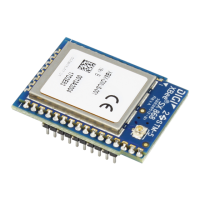Advanced application features Network commissioning and diagnostics
XBee® SX 868 RF Module User Guide
68
Button
Presses
Sleep
configuration and sync status Action
0x95).
1 Configured for synchronous
sleep
Wakes the module for 30 seconds. Immediately
sends a Node Identification broadcast transmission.
All devices that receive this transmission blink their
Associate LED rapidly for 1 second. All API devices
that receive this transmission send a Node
Identification frame out their serial interface (API ID
0x95).
1 Configured for synchronous
sleep
Wakes the module for 30 seconds (or until the
synchronized network goes to sleep). Queues a
Node Identification broadcast transmission sent at
the beginning of the next network wake cycle. All
devices receiving this transmission blink their
Associate LEDs rapidly for 1 second. All API devices
that receive this transmission will send a Node
Identification frame out their serial interface (API ID
0x95).
2 Not configured for
synchronous sleep
No effect.
2 Configured for synchronous
sleep
Causes a node configured with sleeping router
nomination enabled (see the SO command in Sleep
modes to immediately nominate itself as the
network sleep coordinator.
4 Any Issues an ATRE to restore module parameters to
default values.
Use the CB command to simulate button presses in the software. Issue a CB command with a
parameter set to the number of button presses you want executee. For example, sending CB1
executes the actions associated with a single button press.
The node identification frame is similar to the node discovery response frame; it contains the device’s
address, node identifier string (NI command), and other relevant data. All API devices that receive the
node identification frame send it out their serial interface as an API Node Identification Indicator
frame (0x95).
Associate LED
The Associate pin (pin 15) provides an indication of the device's sleep status and diagnostic
information. To take advantage of these indications, connect an LED to the Associate pin.
To enable the Associate LED functionality, set the D5 command to 1; it is enabled by default. If
enabled, the Associate pin is configured as an output. This section describes the behavior of the pin.
Use the LT command to override the blink rate of the Associate pin. If you set LT to 0, the device uses
the default blink time: 500 ms for a sleep coordinator, 250 ms otherwise.
The following table describes the Associate LED functionality.

